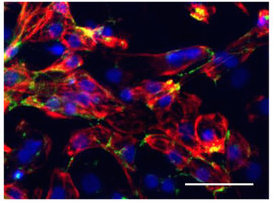
Tube-forming ability of purified CD31+ endothelial cells derived from induced pluripotent stem cells after VEGF treatment.
Chunhui Xu’s lab in the Department of Pediatrics recently published a paper in Stem Cell Reports on the differentiation of endothelial cells, which line and maintain blood vessels. Her lab is part of the Emory-Children’s-Georgia Tech Pediatric Research Alliance. The first author was postdoc Rajneesh Jha.
This line of investigation could eventually lead to artificial blood vessels, grown with patients’ own cells or “off the shelf,” or biological/pharmaceutical treatments that promote the regeneration of damaged blood vessels. These treatments could be applied to peripheral artery disease and/or coronary artery disease.
Xu’s paper concerns the protein LGR5, part of the Wnt signaling pathway. The authors report that inhibiting LGR5 steers differentiating pluripotent stem cells toward endothelial cells and away from cardiac muscle cells. The source iPSCs were a widely used IMR90 line.
Young-sup Yoon’s lab at Emory has also been developing methods for the generation of endothelial cells via “direct reprogramming.”





